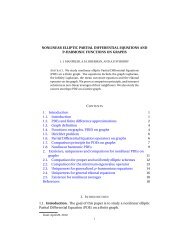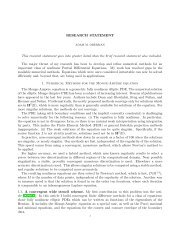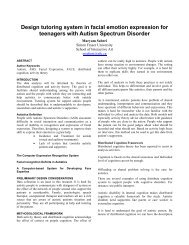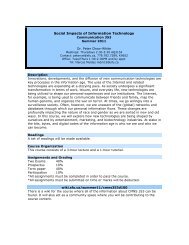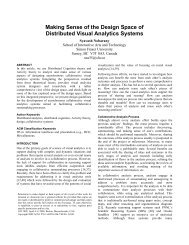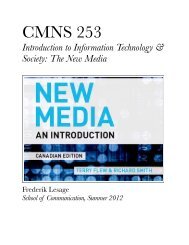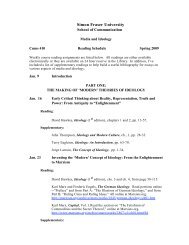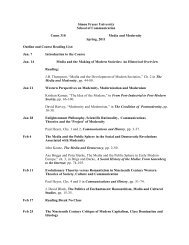CMNS 253 Syllabus - SFU Wiki
CMNS 253 Syllabus - SFU Wiki
CMNS 253 Syllabus - SFU Wiki
Create successful ePaper yourself
Turn your PDF publications into a flip-book with our unique Google optimized e-Paper software.
3. In what ways was privacy a concern in media technology of the past? How does it remaina concern today?4. What ideological or political implications are there to consider in regard to policies,practices, and changes/advances in communications and new media?CHAPTER OUTLINEThis chapter sets new media in its historical context, drawing connections between currentnetwork technologies, convergence trends, and prior inventions such as the telegraph, radio, andtelevision. Although the path has been circuitous, ever since we have been able to send messageswithout moving physical objects (the first telegraph), the immediacy factor has forever changedour expectations about communication media. With new capabilities came new institutions andsocial arrangements and these have proven to be foundational and influential for subsequentgenerations of media.Journalism, politics, and business were all transformed by the use of the telegraph and thetelephone. Radio, and later television, provided a testing ground for key elements of new mediaand in particular the business model in which content could be accessed for free, if one waswilling to accept a little bit of advertising with that content. The chapter concludes with a briefdiscussion of the educational potential of earlier new media.DISCUSSION QUESTIONS1. In what ways has connectivity changed over time? What are some examples ofcommunication technologies that were soon taken for granted? Why might that be the case?2. In your view, is there a problem with over-use of communications technology and newmedia and, if so, with which technologies and what are the consequences?3. To what extent is privacy a concern for you as a user of communications technology andnew media? How has privacy as a concern changed over time?4. What are some changes in how news has historically been moved from one location toanother and what effects have these changes had on how news is captured, presented, andshared? What are the corollary effects on society?5. In what ways does the value of a network increase as more people make use of it (orcould the argument be made that the opposite is true in some cases)? What are some otherconsequences of increased network activity, in terms of points of contact as well as content?6. How has telecommunications technology historically been used for connectivity betweenand among people with shared interests (whether personal, professional, political, etcetera)?7. What are some of the implications of user expectations of free content, whether forcreators of content, copyright owners, vetting of content, quality of content, access tocontent, searching content, etc.? Do such considerations change depending on genre andmedium?



